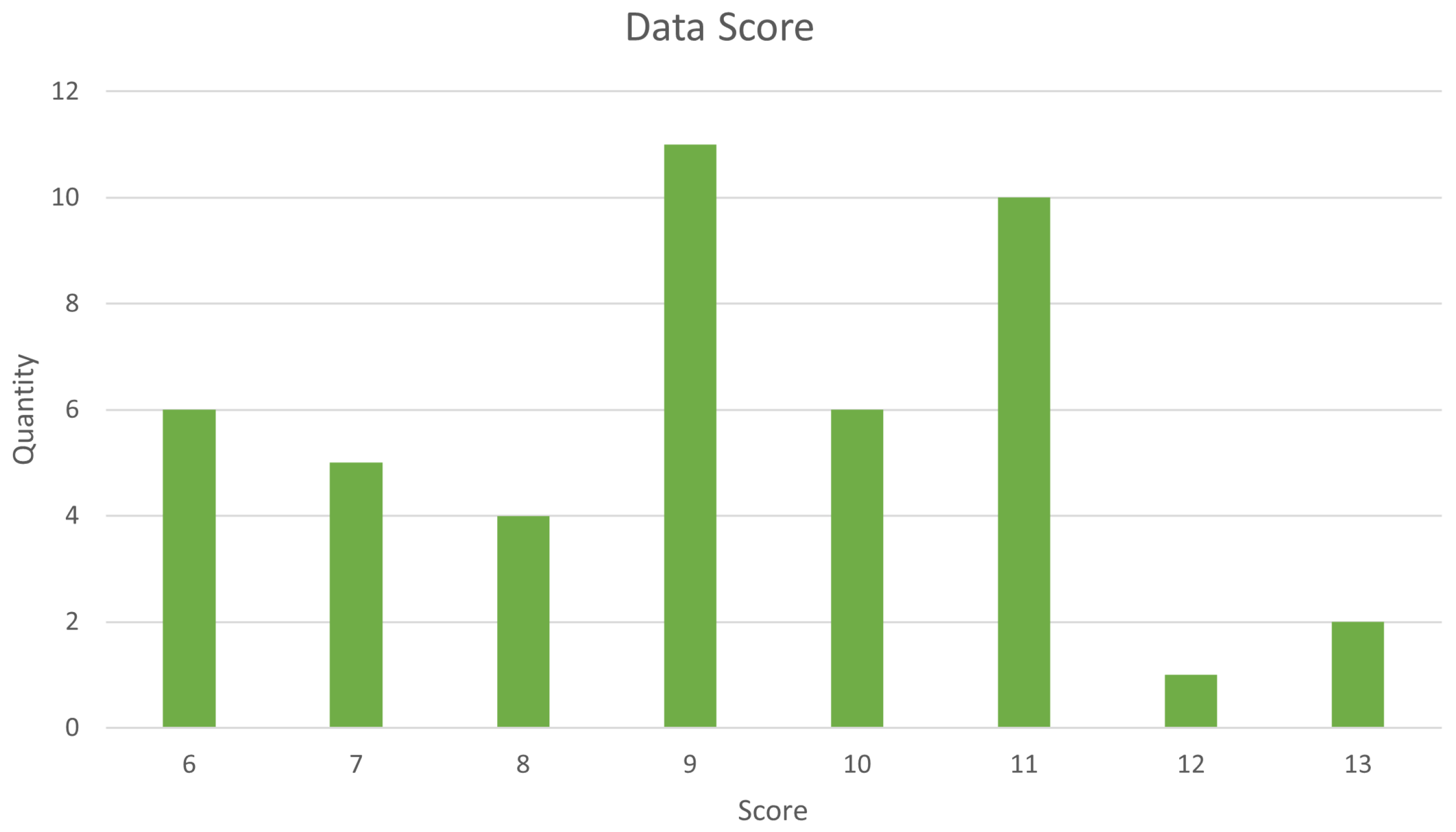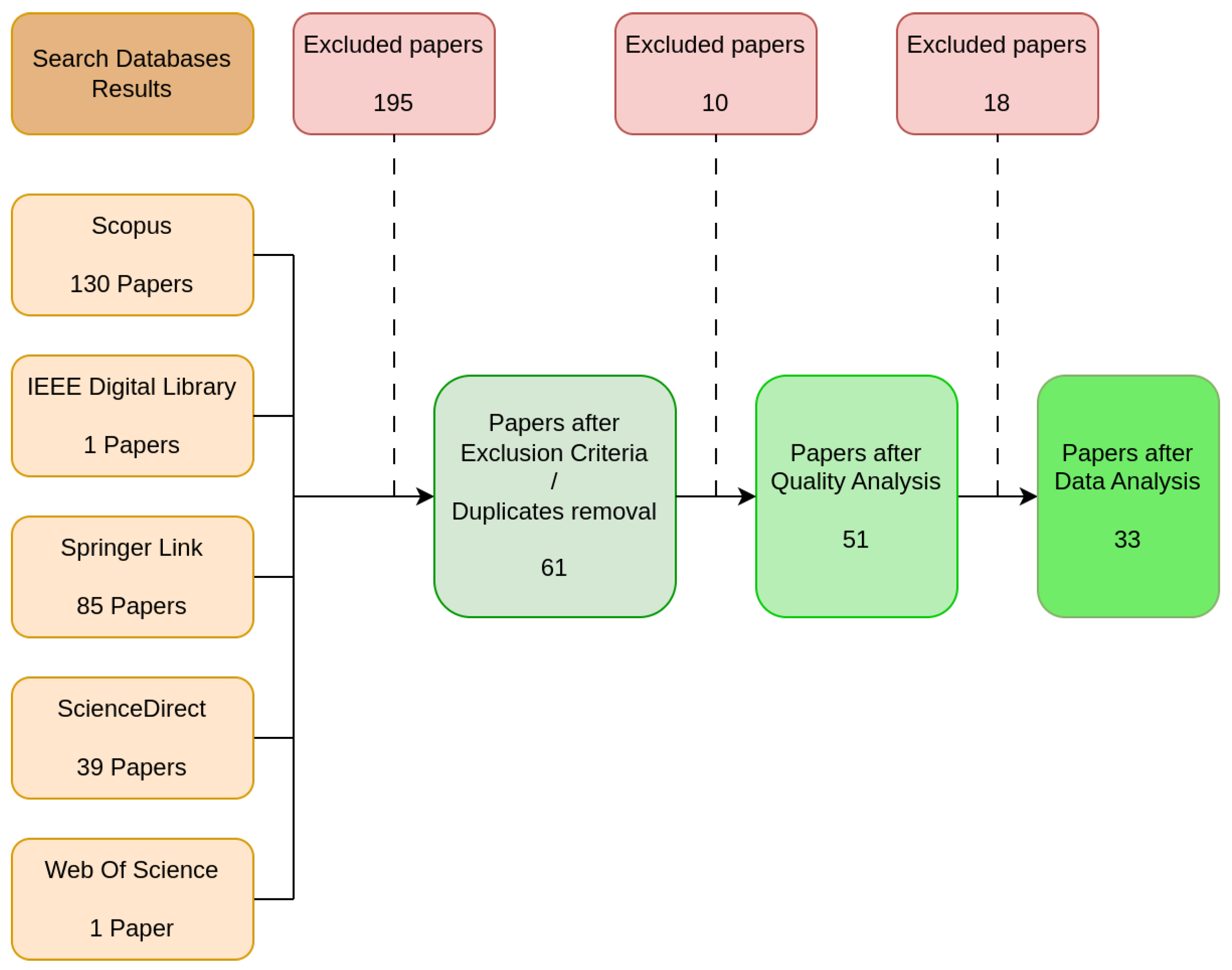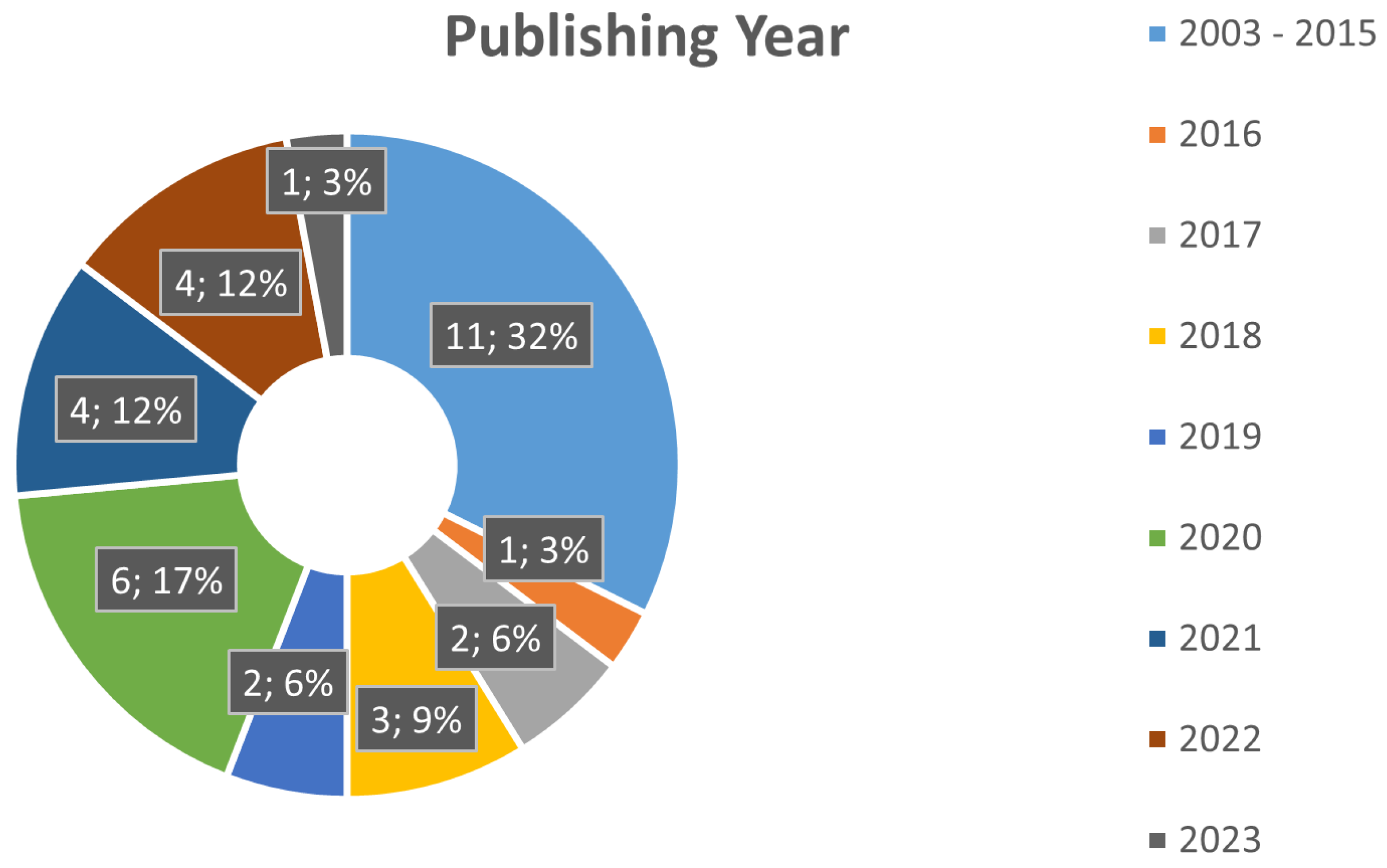Systematic Literature Review on Hybrid Robotic Vehicles
Abstract
1. Introduction
- Collaboration Robots:These are used in several industries to work between robot and human tasks such as sorting and picking.
- Inventory Transportation Robots:These are used to transport inventory within a facility.
- Scalable Storage Picking Robots:These are mainly used to retrieve items from or place items in storage, allowing the operator to access the products quickly.
- AGVs—Automatic Guided Vehicles:These are used in applications such as self-driving forklifts.
- AGVs—Autonomous Guided Vehicles.
- AUVs—Autonomous Underwater Vehicles.
- UAVs—Unmanned Aerial Vehicles.
2. Method
2.1. Planning
- RQ1—Are there recent robotic implementations with legged–wheeled technologies?
- RQ2—Are the recently published works on legged–wheeled robots tested on realistic simulators?
- RQ3—Are the recently published works on legged–wheeled robots tested through a physical prototype?
2.2. Search Process
- ScopusWebsite: https://www.scopus.com( TITLE-ABS-KEY ( robotic AND vehicles ) ) AND ( ( ( ( autonomous ) ) AND ( hybrid ) ) AND ( ( wheeled–legged ) OR (legged-wheeled) ) )
- IEEE Digital LibrarySearch within results: (“All Metadata”: Robotic vehicles) + “Autonomous” + “hybrid” + “wheeled-legged”AND(“All Metadata”: Robotic vehicles) + “Autonomous” + “hybrid” + “legged-wheeled”Both search processes produced the same results.
- ScienceDirectWebsite: https://www.sciencedirect.com/Search String: robotic vehicles AND “autonomous” AND “hybrid” AND (“wheeled-legged” OR “legged-wheeled”)
- Springer LinkWebsite: https://link.springer.com/Search string: robotic AND vehicles AND autonomous AND hybrid AND (wheeled-legged OR legged-wheeled)
- They are well-known and established databases in the robotics field.
- It is possible to use a search string as well as Boolean operators to improve the results of the search process.
2.3. Inclusion and Exclusion Criteria
2.4. Quality Assessment
3. Results
4. Analysis
4.1. Leg–Wheel Implementations
4.2. Leg Implementations
4.3. Wheel Implementations
4.4. Other Implementations
5. Conclusions
Author Contributions
Funding
Data Availability Statement
Conflicts of Interest
References
- Loupos, K.; Doulamis, A.D.; Stentoumis, C.; Protopapadakis, E.; Makantasis, K.; Doulamis, N.D.; Amditis, A.; Chrobocinski, P.; Victores, J.; Montero, R.; et al. Autonomous robotic system for tunnel structural inspection and assessment. Int. J. Intell. Robot. Appl. 2018, 2, 43–66. [Google Scholar] [CrossRef]
- Lame, G. Systematic Literature Reviews: An Introduction. In Proceedings of the Design Society: International Conference on Engineering Design, Delft, The Netherlands, 5–8 August 2019; Volume 1, pp. 1633–1642. [Google Scholar] [CrossRef]
- Kitchenham, B. Procedures for Performing Systematic Reviews; Keele University: Keele, UK, 2004; Volume 33. [Google Scholar]
- Kitchenham, B.A.; Budgen, D. Evidence-Based Software Engineering and Systematic Reviews; CRC Press: Boca Raton, FL, USA, 2015; Volume 4. [Google Scholar]
- Kitchenham, B.; Charters, S. Guidelines for Performing Systematic Literature Reviews in Software Engineering; EBSE: Menen, Belgium, 2007. [Google Scholar]
- Pinto, V.H.; Gonçalves, J.; Costa, P. Design, Modeling, and Control of a Single Leg for a Legged-Wheeled Locomotion System with Non-Rigid Joint. Actuators 2021, 10, 29. [Google Scholar] [CrossRef]
- Pinto, V.H.; Soares, I.N.; Rocha, M.; Lima, J.; Gonçalves, J.; Costa, P. Design, Modeling, and Control of an Autonomous Legged-Wheeled Hybrid Robotic Vehicle with Non-Rigid Joints. Appl. Sci. 2021, 11, 6116. [Google Scholar] [CrossRef]
- Gomez-Bravo, F.; Villadoniga, P.; Carbone, G. Design and Operation of a Novel Hexapod Robot for Surveillance Tasks. In Proceedings of the Advances in Service and Industrial Robotics, Torino, Italy, 6–8 June 2017; Ferraresi, C., Quaglia, G., Eds.; Springer International Publishing: Berlin/Heidelberg, Germany, 2017; pp. 707–715. [Google Scholar]
- Kameduła, M.; Kashiri, N.; Tsagarakis, N.G. Wheeled motion kinematics and control of a hybrid mobility CENTAURO robot. Robot. Auton. Syst. 2020, 128, 103482. [Google Scholar] [CrossRef]
- Wang, W.; Xu, H.; Xu, X.; Zhou, F. Enhancing the Passing Ability of Unmanned Vehicles Using a Variable-Wheelbase Driving System. IEEE Access 2019, 7, 115871–115885. [Google Scholar] [CrossRef]
- Wang, H.Y.; Chen, L.J.; Yu, W.S.; Lin, P.C. A Wheel to Leg Transformation Strategy in a Leg-Wheel Transformable Robot. In Proceedings of the 2023 IEEE/ASME International Conference on Advanced Intelligent Mechatronics (AIM), Seattle, WA, USA, 28–30 June 2023; pp. 293–298. [Google Scholar] [CrossRef]
- Ma, J.; Zhu, M.; Zhang, T.; Yue, X. The Wheel-legged Robot for Guanular Terrain: Guardian. In Proceedings of the 2022 28th International Conference on Mechatronics and Machine Vision in Practice (M2VIP), Nanjing, China, 16–18 November 2022; pp. 1–6. [Google Scholar] [CrossRef]
- Luo, Y.; Li, Q.; Liu, Z. Design and optimization of wheel-legged robot: Rolling-Wolf. Chin. J. Mech. Eng. 2014, 27, 1133–1142. [Google Scholar] [CrossRef]
- Wei, Z.; Song, G.; Qiao, G.; Zhang, Y.; Sun, H. Design and Implementation of a Leg–Wheel Robot: Transleg. J. Mech. Robot. 2017, 9. [Google Scholar] [CrossRef]
- Sharf, I. Dynamic Locomotion with a Wheeled-Legged Quadruped Robot. In Brain, Body and Machine; Angeles, J., Boulet, B., Clark, J.J., Kövecses, J., Siddiqi, K., Eds.; Springer: Berlin/Heidelberg, Germany, 2010; pp. 299–310. [Google Scholar]
- Qiao, G.; Song, G.; Zhang, Y.; Zhang, J.; Li, Z. A Wheel-legged Robot with Active Waist Joint: Design, Analysis, and Experimental Results. J. Intell. Robot. Syst. 2016, 83, 485–502. [Google Scholar] [CrossRef]
- Xue, J.; Wang, S.; Wang, J.; Chen, Z. Stewart-Inspired Vibration Isolation Control for a Wheel-legged Robot via Variable Target Force Impedance Control. J. Intell. Robot. Syst. 2022, 106, 61. [Google Scholar] [CrossRef]
- Michaud, F.; Létourneau, D.; Arsenault, M.; Bergeron, Y.; Cadrin, R.; Gagnon, F.; Legault, M.A.; Millette, M.; Paré, J.F.; Tremblay, M.C.; et al. Multi-Modal Locomotion Robotic Platform Using Leg-Track-Wheel Articulations. Auton. Robot. 2005, 18, 137–156. [Google Scholar] [CrossRef]
- Kwak, B.; Bae, J. Design and Analysis of a Rotational Leg-type Miniature Robot with an Actuated Middle Joint and a Tail (RoMiRAMT-II). J. Bionic Eng. 2018, 15, 356–367. [Google Scholar] [CrossRef]
- Khazaee, M.; Sadedel, M.; Davarpanah, A. Behavior-Based Navigation of an Autonomous Hexapod Robot Using a Hybrid Automaton. J. Intell. Robot. Syst. 2021, 102, 29. [Google Scholar] [CrossRef]
- Azpúrua, H.; Rezende, A.; Potje, G.; Júnior, G.P.d.C.; Fernandes, R.; Miranda, V.; Filho, L.W.d.R.; Domingues, J.; Rocha, F.; de Sousa, F.L.M.; et al. Towards Semi-autonomous Robotic Inspection and Mapping in Confined Spaces with the EspeleoRobô. J. Intell. Robot. Syst. 2021, 101, 69. [Google Scholar] [CrossRef]
- Karamipour, E.; Dehkordi, S.F.; Korayem, M.H. Reconfigurable Mobile Robot with Adjustable Width and Length: Conceptual Design, Motion Equations and Simulation. J. Intell. Robot. Syst. 2020, 99, 797–814. [Google Scholar] [CrossRef]
- Mardani, A.; Ebrahimi, S.; Alipour, K. New Adaptive Segmented Wheel for Locomotion Improvement of Field Robots on Soft Terrain. J. Intell. Robot. Syst. 2020, 97, 695–717. [Google Scholar] [CrossRef]
- McGinn, C.; Cullinan, M.F.; Otubela, M.; Kelly, K. Design of a terrain adaptive wheeled robot for human-orientated environments. Auton. Robot. 2019, 43, 63–78. [Google Scholar] [CrossRef]
- Delgado-Mata, C.; Velázquez, R.; Gutiérrez, C.A. A Differential-Drive Mobile Robot Driven by an Ethology Inspired Behaviour Architecture. Procedia Technol. 2012, 3, 157–166. [Google Scholar] [CrossRef]
- Bai, L.; Guan, J.; Chen, X.; Hou, J.; Duan, W. An optional passive/active transformable wheel-legged mobility concept for search and rescue robots. Robot. Auton. Syst. 2018, 107, 145–155. [Google Scholar] [CrossRef]
- Chocoteco, J.; Morales, R.; Feliu, V. Improving the climbing/descent performance of stair-climbing mobility systems confronting architectural barriers with geometric disturbances. Mechatronics 2015, 30, 11–26. [Google Scholar] [CrossRef]
- Grand, C.; Benamar, F.; Plumet, F. Motion kinematics analysis of wheeled–legged rover over 3D surface with posture adaptation. Mech. Mach. Theory 2010, 45, 477–495. [Google Scholar] [CrossRef]
- Sun, Y.; Ma, S.; Yang, Y. Planning of Legged Race-walking Gait for an ePaddle-based Amphibious Robot. IFAC Proc. Vol. 2012, 45, 218–223. [Google Scholar] [CrossRef]
- Mertyüz, İ.; Tanyıldızı, A.K.; Taşar, B.; Tatar, A.B.; Yakut, O. FUHAR: A transformable wheel-legged hybrid mobile robot. Robot. Auton. Syst. 2020, 133, 103627. [Google Scholar] [CrossRef]
- Pu, H.; Zhao, J.; Sun, Y.; Ma, S.; Luo, J.; Gong, Z. Non-reciprocating legged gait for robot with epicyclic-gear-based eccentric paddle mechanism. Robot. Auton. Syst. 2015, 68, 36–46. [Google Scholar] [CrossRef]
- Song, Z.; Luo, Z.; Wei, G.; Shang, J. A Portable Six-Wheeled Mobile Robot With Reconfigurable Body and Self-Adaptable Obstacle-Climbing Mechanisms. J. Mech. Robot. 2022, 14, 051010. [Google Scholar] [CrossRef]
- Edwin, L.; Mazzoleni, A.; Gemmer, T.; Ferguson, S. Modeling, construction and experimental validation of actuated rolling dynamics of the cylindrical Transforming Roving-Rolling Explorer (TRREx). Acta Astronaut 2017, 132, 43–53. [Google Scholar] [CrossRef]
- Liu, J.; Tian, Y.; Gao, F. A novel six-legged walking machine tool for in-situ operations. Front. Mech. Eng. 2020, 15, 351–364. [Google Scholar] [CrossRef]
- Qiang, Z.; Zengbo, L.; Yao, C. A Back-stepping Based Trajectory Tracking Controller for a Non-chained Nonholonomic Spherical Robot. Chin. J. Aeronaut. 2008, 21, 472–480. [Google Scholar] [CrossRef]
- Koshy, M.; Nair, A.R.; Krishnan, A. Design, Manufacturing and Testing of a Hybrid Locomotion Mobile Robot “HyLMoR”. Mater. Today Proc. 2020, 24, 1292–1301. [Google Scholar] [CrossRef]
- Lacagnina, M.; Muscato, G.; Sinatra, R. Kinematics, dynamics and control of a hybrid robot Wheeleg. Robot. Auton. Syst. 2003, 45, 161–180. [Google Scholar] [CrossRef]
- Chang, W.J.; Chang, C.L.; Ho, J.H.; Lin, P.C. Design and implementation of a novel spherical robot with rolling and leaping capability. Mech. Mach. Theory 2022, 171, 104747. [Google Scholar] [CrossRef]





| Inclusion Criteria | Criteria |
|---|---|
| IC1 | Papers are written in English (AND) |
| IC2 | Papers regard a possible physical robotic implementation and are NOT a review of several different existing robots (AND) |
| IC3 | Papers are reported in peer-reviewed conferences OR journals OR technical reports (AND) |
| IC4 | Papers use ground hybrid vehicles OR legged–wheeled robotic vehicles OR wheeled–legged robotic vehicles. |
| Exclusion Criteria | Criteria |
|---|---|
| EC1 | Papers are NOT written in English (OR) |
| EC2 | Paper do NOT regard a possible physical robotic implementation OR are a review of several different existing robots (OR) |
| EC3 | Papers are NOT reported in peer-reviewed conferences OR journals OR technical reports (OR)) |
| EC4 | Papers do NOT use ground hybrid vehicles OR legged–wheeled robotic vehicles OR wheeled–legged robotic vehicles. |
| Quality Questions | Question |
|---|---|
| QQ1 | Is the paper based on scientific research? |
| QQ2 | Is the context of the study described? |
| QQ3 | Is the objective of the paper clear? |
| QQ4 | Is the method used during the study described? |
| QQ5 | Is the study of value for the research field? |
| Data Questions | Question |
|---|---|
| DQ1 | Is the robot autonomous? |
| DQ2 | Is the robot implementation based on previous work? |
| DQ3 | Is the robot locomotion of a hybrid nature? |
| DQ4 | Is the modeling of the vehicle explained? |
| DQ5 | Is the design of the vehicle explained? |
| DQ6 | Is the control of the vehicle explained? |
| DQ7 | Is the robot research completed? |
| Research Questions Results | Selected Articles |
|---|---|
| RQ1—Are there recent robotic implementations with wheel–leg technologies? | [6,7,8,9,10,11,12,13,14,15,16,17,18,19,20,21,22,23,24,25,26,27,28,29,30,31] |
| RQ2—Have such works been tested through simulation? | [6,7,8,9,10,11,12,13,14,16,17,18,19,20,21,22,23,24,26,27,28,29,30,31,32,33,34,35,36,37,38] |
| RQ3—Have such works been tested through physical prototypes? | [7,8,9,11,12,14,15,16,17,18,19,21,23,24,32,33,34] |
| Paper | DQ1 | DQ2 | DQ3 | DQ4 | DQ5 | DQ6 | DQ7 | Score |
|---|---|---|---|---|---|---|---|---|
| [6] | Y | NEW | Y | Y | Y | Y | N | 11 |
| [7] | Y | NEW | Y | Y | Y | Y | N | 11 |
| [8] | N | NEW | Y | Y | Y | Y | YN | 10 |
| [9] | Y | NEW | Y | Y | Y | Y | N | 11 |
| [10] | Y | NEW | Y | y | y | y | N | 11 |
| [11] | yn | OLD | y | y | y | y | n | 9 |
| [12] | Y | NEW | Y | Y | Y | Y | Y | 13 |
| [32] | N | NEW | Y | Y | Y | Y | N | 9 |
| [13] | Y | NEW | Y | Y | Y | Y | N | 11 |
| [33] | N | NEW | Y | Y | Y | Y | N | 9 |
| [14] | N | NEW | Y | Y | Y | Y | YN | 10 |
| [15] | YN | NEW | Y | Y | Y | Y | YN | 11 |
| [16] | Y | NEW | Y | Y | Y | Y | N | 11 |
| [17] | Y | NEW | N | Y | Y | Y | N | 9 |
| [18] | Y | NEW | Y | Y | Y | YN | N | 10 |
| [19] | Y | NEW | Y | YN | Y | YN | N | 9 |
| [20] | y | OLD | Y | Y | Y | Y | YN | 11 |
| [21] | Y | OLD | Y | Y | Y | Y | N | 10 |
| [22] | Y | OLD | Y | Y | Y | Y | N | 10 |
| [23] | Y | NEW | N | Y | Y | Y | N | 9 |
| [34] | Y | NEW | Y | Y | Y | Y | Y | 13 |
| [24] | Y | NEW | Y | Y | Y | N | N | 9 |
| [35] | Y | OLD | N | Y | YN | Y | Y | 9 |
| [36] | Y | NEW | Y | YN | Y | Y | N | 10 |
| [25] | Y | OLD | Y | Y | Y | N | Y | 10 |
| [26] | Y | NEW | Y | Y | Y | Y | N | 11 |
| [37] | Y | OLD | Y | Y | YN | Y | N | 9 |
| [27] | Y | OLD | Y | Y | Y | Y | Y | 12 |
| [38] | Y | NEW | Y | Y | Y | Y | N | 11 |
| [28] | Y | OLD | Y | Y | YN | Y | Y | 11 |
| [29] | Y | OLD | Y | Y | YN | Y | N | 9 |
| [30] | Y | NEW | Y | Y | Y | Y | N | 11 |
| [31] | Y | OLD | Y | Y | YN | Y | N | 9 |
Disclaimer/Publisher’s Note: The statements, opinions and data contained in all publications are solely those of the individual author(s) and contributor(s) and not of MDPI and/or the editor(s). MDPI and/or the editor(s) disclaim responsibility for any injury to people or property resulting from any ideas, methods, instructions or products referred to in the content. |
© 2024 by the authors. Licensee MDPI, Basel, Switzerland. This article is an open access article distributed under the terms and conditions of the Creative Commons Attribution (CC BY) license (https://creativecommons.org/licenses/by/4.0/).
Share and Cite
Gomes, D.F.; Pinto, V.H. Systematic Literature Review on Hybrid Robotic Vehicles. Robotics 2024, 13, 34. https://doi.org/10.3390/robotics13030034
Gomes DF, Pinto VH. Systematic Literature Review on Hybrid Robotic Vehicles. Robotics. 2024; 13(3):34. https://doi.org/10.3390/robotics13030034
Chicago/Turabian StyleGomes, Diogo F., and Vítor H. Pinto. 2024. "Systematic Literature Review on Hybrid Robotic Vehicles" Robotics 13, no. 3: 34. https://doi.org/10.3390/robotics13030034
APA StyleGomes, D. F., & Pinto, V. H. (2024). Systematic Literature Review on Hybrid Robotic Vehicles. Robotics, 13(3), 34. https://doi.org/10.3390/robotics13030034







